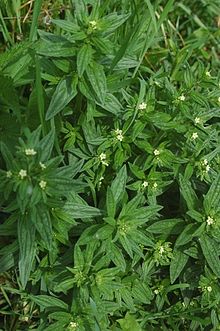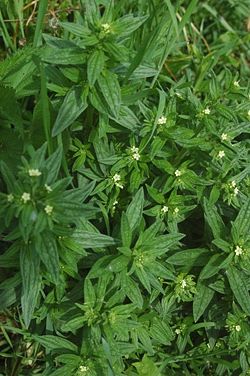mk
имиња во трошки


Lithospermum erythrorhizon, commonly called purple gromwell, red stoneroot, red gromwell, red-root gromwell and redroot lithospermum, is a plant species in the genus Lithospermum.[1] It is called zǐcǎo (紫草) in Chinese, jichi (지치) in Korean, and murasaki (ムラサキ; 紫) in Japanese.[1]
The dried root of Lithospermum erythrorhizon (lithospermum root or Lithospermi Radix) is a Chinese herbal medicine with various antiviral and biological activities, including inhibition of human immunodeficiency virus type 1 (HIV-1).[2][3]
The genome sequence of Lithospermum erythrorhizon is sequenced and has facilitated the discovery of a putative retrotransposition-derived duplication event that produced a 4-hydroxybenzoate geranyltransferase gene involved in alkannin biosynthesis.[4]
The enzyme 4-hydroxybenzoate geranyltransferase utilizes geranyl diphosphate and 4-hydroxybenzoate to produce 3-geranyl-4-hydroxybenzoate and diphosphate. Biosynthetically, alkannin is produced in plants from the intermediates 4-hydroxybenzoic acid and geranyl pyrophosphate. This enzyme is involved in shikonin biosynthesis.
The enzyme geranylhydroquinone 3''-hydroxylase uses geranylhydroquinone, NADPH, H+ and O2 to produce 3-hydroxygeranylhydroquinone, NADP+ and H2O.
It has been cultivated in Japan since the Nara period for its root, which can be used for herbal medicine and to make dyes.[5][6]
Before the introduction of synthetic dyes to Meiji period Japan, the roots were commonly used as a dyestuff for luxury textiles, typically high-end kimono and obi. The process of extracting purple dyestuff from the roots was an exceedingly long, complex and time-consuming process, necessitating its relatively high expense:
The roots [of the plant] are collected and dried for two to three months to mature the color. While this occurs, the silk is pre-mordanted [...] the mordanting process involves repeated immersion of the cloth or yarn in the alum bath and drying over a two- or three-month period. To prepare the dyestuff, the gromwell roots are softened overnight in 60° [Celsius] water and then pounded to release the dye. The silk is then repeatedly immersed in the bath, aired to allow more oxygen to penetrate the cloth and then steeped in the dye until the desired color is achieved. When the dyeing is completed the cloth is placed in dark storage for as long as a year while the color continues to mature.[7]
For a deep purple, up to 50 dips could be needed. Shikonzome dye loses colour remarkably fast, literally as the fibers are being dipped, meaning it was often used for bokashi (ombré) dying, and the resulting colour was varied and uneven, with each strand a slightly different shade.[8]
One Japanese word for the plant, murasaki (紫), inspired the pen name "Lady Murasaki" for the author of The Tale of Genji and is also the source of the general Japanese term for the color purple, murasaki iro (紫色).[9] Additional terms were used for specific shades of purple within this range, particularly during the Heian period; names such as usuki murasaki ("pale purple") and asaki murasaki ("light purple") formed important distinctions when dressing in specifically-layered clothing, and could also indicate (typically high) rank.[10]
The dyes made from its root also had other names, such as shikon (紫根),[11] but all of them were difficult to work with because of their requirement for an alum-rich mordant and the resulting colors' extreme vulnerability to photobleaching. During the Heian Period, sumptuary laws restricted murasaki-dyed clothing to the Empress and her ladies in waiting.
{{cite web}}: Missing or empty |title= (help)  Lithospermum erythrorhizon, with flowers
Lithospermum erythrorhizon, with flowers Lithospermum erythrorhizon, commonly called purple gromwell, red stoneroot, red gromwell, red-root gromwell and redroot lithospermum, is a plant species in the genus Lithospermum. It is called zǐcǎo (紫草) in Chinese, jichi (지치) in Korean, and murasaki (ムラサキ; 紫) in Japanese.
The dried root of Lithospermum erythrorhizon (lithospermum root or Lithospermi Radix) is a Chinese herbal medicine with various antiviral and biological activities, including inhibition of human immunodeficiency virus type 1 (HIV-1).
The genome sequence of Lithospermum erythrorhizon is sequenced and has facilitated the discovery of a putative retrotransposition-derived duplication event that produced a 4-hydroxybenzoate geranyltransferase gene involved in alkannin biosynthesis.
Puna-rusujuur (Lithospermum erythrorhizon Siebold et Zucc) on üks rusujuure (Lithospermum) liike, Ida-Aasias tuntud ravim- ja värvitaim. Hiina keeles on see zǐcǎo (紫草), korea keeles jichi (지치)ja jaapani keeles murasaki (ムラサキ; 紫)[1].
Puna-rusujuure juurtest toodetakse kallist värvainet jaapanikeelse nimega shikon, mis annab tekstiilikiududele violetse, sinakapoolse purpuriga sarnaneva värvuse. Shikon on tuntud ka nime all tokio violett[2]. Värvaine peamine keemiline komponent on naftokinoonide hulka kuuluv orgaaniline ühend šikoniin[3]. Peitsainena kasutatakse tuhaleelist, tulemus võib sõltuda ka vee omadustest[4].
Puna-rusujuur U.S. National Plant Germplasm System portaalis GRIN Global
Puna-rusujuur (Lithospermum erythrorhizon Siebold et Zucc) on üks rusujuure (Lithospermum) liike, Ida-Aasias tuntud ravim- ja värvitaim. Hiina keeles on see zǐcǎo (紫草), korea keeles jichi (지치)ja jaapani keeles murasaki (ムラサキ; 紫).
Puna-rusujuure juurtest toodetakse kallist värvainet jaapanikeelse nimega shikon, mis annab tekstiilikiududele violetse, sinakapoolse purpuriga sarnaneva värvuse. Shikon on tuntud ka nime all tokio violett. Värvaine peamine keemiline komponent on naftokinoonide hulka kuuluv orgaaniline ühend šikoniin. Peitsainena kasutatakse tuhaleelist, tulemus võib sõltuda ka vee omadustest.
Lithospermum erythrorhizon là loài thực vật có hoa trong họ Mồ hôi. Loài này được Siebold & Zucc. mô tả khoa học đầu tiên năm 1846.[1]
Lithospermum erythrorhizon là loài thực vật có hoa trong họ Mồ hôi. Loài này được Siebold & Zucc. mô tả khoa học đầu tiên năm 1846.
紫草(学名:Lithospermum erythrorhizon)又名藐、茈草(《爾雅》)、紫丹、紫芙(《神農本草經》)、鴉銜草(《本草綱目》)。 为紫草科紫草属的植物。分布于日本、朝鲜以及中国大陆的辽宁、山西、湖南、甘肃、山东、湖北、广西、四川、陕西、贵州、江西、河北、河南等地,生长于海拔50米至2,500米的地区,多生长在山坡草地,属中国原产的植物(非从国外引种)。紫草根含紫草醌、乙醯紫草素、去氧紫草素、異丁基紫草素、異戊醯紫草素、β, β-二甲基丙烯醯紫草素等成分。
紫草(学名:Lithospermum erythrorhizon)又名藐、茈草(《爾雅》)、紫丹、紫芙(《神農本草經》)、鴉銜草(《本草綱目》)。 为紫草科紫草属的植物。分布于日本、朝鲜以及中国大陆的辽宁、山西、湖南、甘肃、山东、湖北、广西、四川、陕西、贵州、江西、河北、河南等地,生长于海拔50米至2,500米的地区,多生长在山坡草地,属中国原产的植物(非从国外引种)。紫草根含紫草醌、乙醯紫草素、去氧紫草素、異丁基紫草素、異戊醯紫草素、β, β-二甲基丙烯醯紫草素等成分。

 分類 界 : 植物界 Plantae 門 : 被子植物門 Magnoliophyta 綱 : 双子葉植物綱 Magnoliopsida 目 : シソ目 Lamiales 科 : ムラサキ科 Boraginaceae 属 : ムラサキ属 Lithospermum 種 : ムラサキ L. erythrorhizon 学名 Lithospermum erythrorhizon
分類 界 : 植物界 Plantae 門 : 被子植物門 Magnoliophyta 綱 : 双子葉植物綱 Magnoliopsida 目 : シソ目 Lamiales 科 : ムラサキ科 Boraginaceae 属 : ムラサキ属 Lithospermum 種 : ムラサキ L. erythrorhizon 学名 Lithospermum erythrorhizonムラサキ(紫、Lithospermum erythrorhizon)はムラサキ科の植物の一種。多年草で、初夏から夏にかけて白い花を咲かせる。栽培用には、同属異種のセイヨウムラサキ(L. officinale L.)が利用されることが多い。
根は暗紫色で、生薬「シコン」(紫根)である。この生薬は日本薬局方に収録されており、抗炎症作用、創傷治癒の促進作用、殺菌作用などがあり、紫雲膏などの漢方方剤に外用薬として配合される。最近では、日本でも抗炎症薬として、口内炎・舌炎の治療に使用される。
古くから紫色の染料として用いられてきた。色を染めるには、乾燥した紫根を粉にし、微温湯で抽出して灰汁で媒染して染色する。江戸時代には染められた絹を鉢巻にして、病気平癒の為に頭に巻く風習が生まれた(病鉢巻)。
染料の成分および薬用成分はナフトキノン誘導体のシコニン (Shikonin) で、最近ではバイオテクノロジーにより大量生産されて口紅などに用いられている。
万葉集にもその名が出るほど歴史は古く、奈良時代から江戸時代末期まで栽培が行われてきた。しかし、明治時代以降は合成染料の登場により商業的価値を失い、ムラサキ自体も絶滅危惧種レッドデータブックIBにランクされるまでになってしまった。そのため、現在も熱心な愛好家たちが栽培を試みているが、種の発芽率が低い上、ウイルスなどに弱いため、株を増やすのは困難である。このため、現在では中国から近縁種(下記)が輸入され、ムラサキとして流通しているが、ムラサキとの交雑により純正種を脅かすことになっている。
最近健康食品として、美白に効果があるなとして広く販売されているが、肝癌などを誘発するピロリジジンアルカロイドを含有するため、注意が必要である。近縁種についても同様の危険がある。(詳しくはピロリジジンアルカロイドを参照)
ムラサキ(紫、Lithospermum erythrorhizon)はムラサキ科の植物の一種。多年草で、初夏から夏にかけて白い花を咲かせる。栽培用には、同属異種のセイヨウムラサキ(L. officinale L.)が利用されることが多い。
지치는 지치과의 여러해살이풀이다.
뿌리가 보랏빛을 띤다고 자초(紫草)라 한 것이 지초(芝草)로 결국 지치로 부르게 되었다. 자초, 지초, 지추라고도 부른다.[1]
주로 산이나 들에서 자라며, 한국 각지에 분포하고 있다. 뿌리는 굵고 자색을 띠며, 줄기의 높이는 30~35센티미터 정도이다. 잎은 피침형으로 두꺼우며 어긋난다. 잎자루는 없고, 잎이나 줄기에는 센 털이 나 있다. 꽃은 흰색으로, 5~6월쯤 가지 끝에 총상꽃차례를 이루면서 달린다. 열매는 작은 견과이다.[2]
유독 성분이 들어 있어서 날것으로 먹어서는 안 된다. 뜨거운 물에 데치고 나서 며칠 동안 흐르는 물에 우려낸 뒤에 나물로 무쳐 먹는다.[1] 약초학에서는 자초근(紫草根)이라하여 말린 지치의 뿌리를 한방에서 이르는 말로 홍역(紅疫), 창양(瘡瘍), 습진 따위에 쓴다.
지치는 지칫과의 개지치, 들지치, 반디지치, 산지치 따위를 통틀어 이르는 말로 지칫과의 여러해살이풀을 가리킨다. 지치(Lithospermum erythrorhizon) 줄기는 높이가 30~60cm이며, 잎은 어긋나고 피침 모양이다. 5~6월에 흰색 꽃이 총상(總狀) 화서로 피고 열매는 작은 견과(堅果)를 맺는데 뿌리는 약용하거나 자주색 염료로 쓴다.